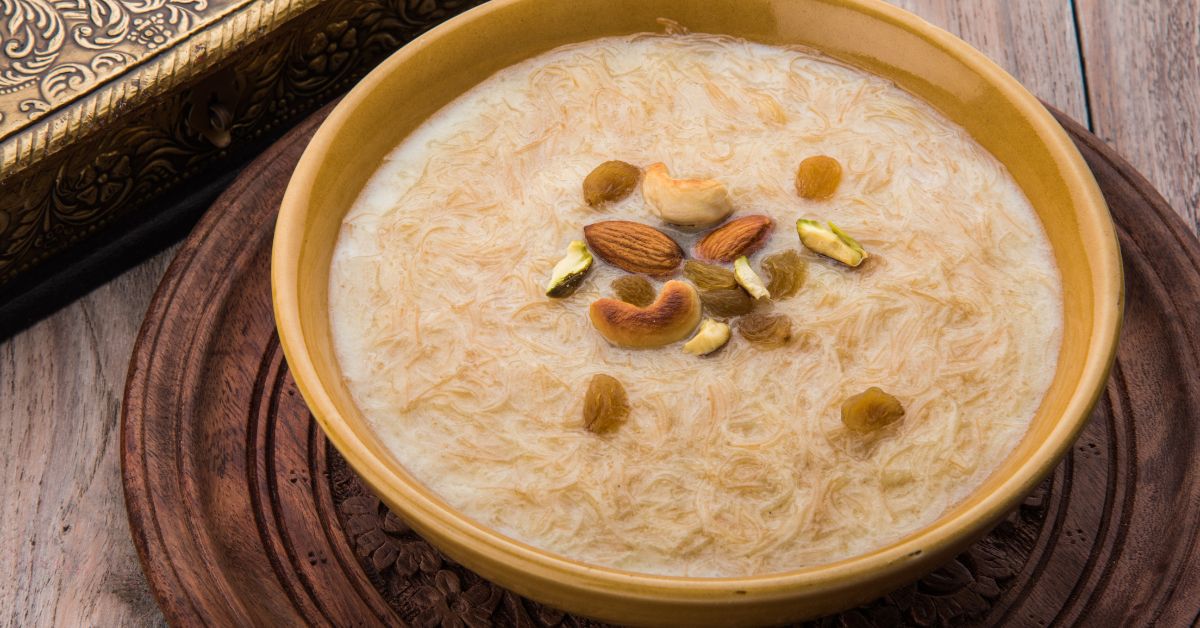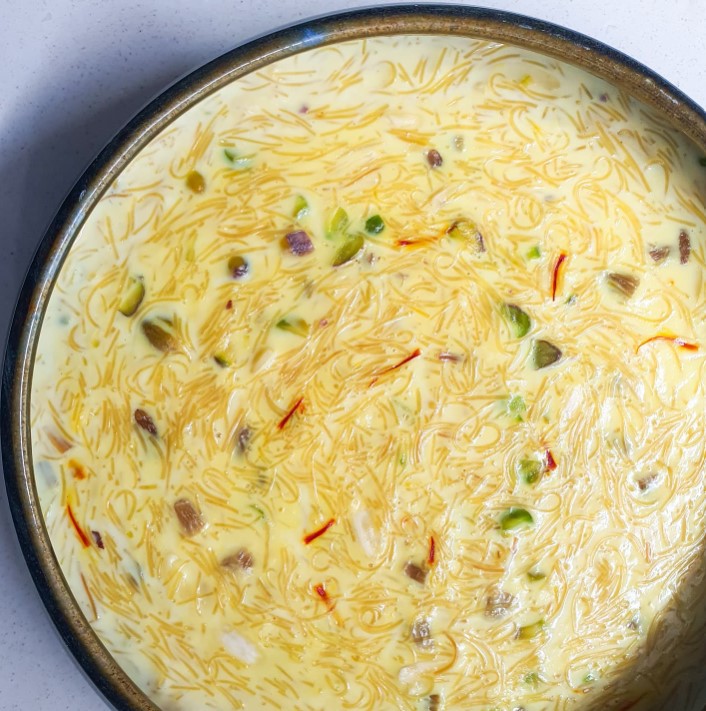Eid Special: Love Seviyan? Here’s How The Sweet Treat Won Over India
Seviyan or vermicelli’s Indian adaptations range from the beloved seviyan kheer in the North to the semiya upma in the South. Let’s explore the ingredient’s versatility as it found its way into the heart of the subcontinent.

The festival of Eid evokes nostalgia. School days were reminiscent of gathering around the table with my friends, waiting for the feast that would follow the fast during Ramadan.
A table creaking under the weight of iftar (the fast-breaking evening meal) would signal the end of the day’s fast. Hours of abstaining from food and drink would make my friends hungry enough to devour everything in front of them, I would think. But I’d watch in awe as they elegantly took some khajoor (dates), followed by fresh fruits and then meaty snacks, and the likes. The iftar would then be washed down with a drink of roohafza (a refreshing drink made with basil seeds, fruits, herbs and flowers).
But among many other delicacies set before us, one dish reigned supreme — ‘seviyan’, a vermicelli pudding made with ghee, rice vermicelli noodles, milk, spices, and a sweetener. While it is a common guest at the iftar feast, my friend Thousif Raza explains it is its fancier cousin ‘sheer khurma’ that makes an appearance on Eid. “Sheer khurma is made with extra khoya (thickened milk) and dry fruits — a richer version of the seviyan.”
But nevertheless, the creamy concoctions are fit for kings. Once prepared for royalty, the dish reflects regional sensibilities, with each diaspora adding to it what they deem best.
The origins of the vermicelli, one of the main ingredients in seviyan, are hidden by the passage of time. Translating to ‘little worms’, these thin rice noodles have been a part of diets as far back as the 1660s. And, each cuisine has embraced a different form of it in its dishes.

An ironic coloured history
Neutral shades with hints of yellow is how a culinary aficionado would describe the vermicelli. In Italy, the vermicelli features in both sweet and savoury dishes. When mixed with tomatoes, garlic and anchovies, it makes for great spaghetti, while a 14th-century recipe highlighted how it blended well with wheat flour, almonds, eggs and sugar.
A 1770 American cookbook ‘The Art of Cookery’ spoke of how the vermicelli made an excellent meal when blended well with egg yolks and flour.
Asian cuisine embraced vermicelli and its many forms right since the Qin dynasty dating back to 221 BCE; whether as mi fen (rice noodles), or mung bean vermicelli (cellophane or glass noodles), or misua (wheat-based vermicelli).
Coming to the Indian variations of vermicelli, local lore tells us that the only way perhaps that vermicelli made its way into the subcontinent is through trade networks extending between the Middle East and India. In fact, in Egypt, the technique of frying vermicelli (she’reya) in butter or oil was prevalent. Once fried, water would be added to the fried noodles and it would be cooked with rice. A hearty meal!
An article in the Deccan Herald explores the origins of the sweet dish. Hand rolling of seviyan, which was once a traditional occupation, gained popularity during the time of the Mughal rule. In fact, it is said that Emperor Humayun ignited the love for seviyan in the court by reintroducing the Persian kurma as dum ki seviyan. But, it was Emperor Shah Jahan who was instrumental in the dish becoming its current version with spices, ghee and dry fruits. An anecdote often told is how the Emperor requested a special sunset-coloured varq (an edible foil garnishing) to accompany the seviyan. This tradition lasted until the time of Bahadur Shah Zafar who would prepare his seviyan by hand.
Once the ingredient entered India, it was local palate preferences that gave birth to the many vermicelli-based dishes that now exist.
The ‘Oxford Companion to Food’ by Alan Davidson and Tom Jaine, says the following about seviyan: The Sanskrit name for noodles is sevika, which may derive from an unrecorded word meaning thread connected with the root siv, which refers to sewing. Sev are crisp fried noodles prepared from besan (chickpea) flour. Seviyan (also seviya, sivayya, shavayi) usually refers to a sweet dish of vermicelli noodles.

Once you enter India, you are certain to get a whiff of the aromas of multiple delicious preparations which feature vermicelli as the hero ingredient. Known as shavige, semiya and sevalu, vermicelli in India takes on new avatars as we go from South to North and East to West.
No breakfast in South India is complete without an order for semiya upma (a dish made with a mixture of vermicelli and vegetables), while in the North the fuss-free namkeen seviyan (savoury vermicelli) has many fans.
But South or North, everyone concedes that there is no rival for the seviyan kheer (a vermicelli pudding made with ghee, rice vermicelli noodles, milk, spices, and a sweetener). And that brings us back to our Eid story.
History sprinkled with a dash of sweetness
Vermicelli’s entry into India was marked by every region putting its own spin on the dish. In the West, adding saffron and chopped nuts to the vermicelli is a common practice while in the North, this is substituted with khoya. In the South, coconut milk is added to get a thick consistency while those in Odisha and West Bengal prefer adding rosewater.
The way vermicelli is cooked depends upon the festive occasion too. For instance, during Raksha Bandhan, some people prepare meethe java (vermicelli pudding). The “auspicious” short noodles used in the dish are a version of the thinner, longer seviyan.
Coming to the beloved summer drink, falooda features thicker glutinous strands of vermicelli dunked into a syrup and served with ice cream. The dessert traces back to faloodeh of Persian cuisine where the vermicelli would be made from frozen cornstarch, mixed with rose water, lime juice and pistachios.
Within seviyan too, there are different varieties. I recall Eid feasts with friends, where half of the group preferred the flowy version of the dessert (which resembled a kheer cooked with milk), and the other half would argue that the dry version (vermicelli sweet made by frying the noodles in ghee, adding syrup and nuts) was more delicious. I belonged to the former!
Whatever your preference for seviyan, it suffices to say that the dish is not just a meal, but an emotion for many.
So, here’s a recipe for seviyan by chef Sanjeev Kapoor that you can try out this festive season.
Ingredients (serves four):
10 g vermicelli (seviyan)
3 tbsp pure ghee
1 tsp green cardamom powder
1/2 cup sugar
Method:
Step 1: Heat ghee in a kadai.
Step 2: Break the vermicelli roughly and sauté it in the ghee till it turns golden.
Step 3: Add one and a half cups of water and green cardamom powder, and simmer it till the water gets absorbed.
Step 4: Add sugar, mix well, and cook till the sugar gets dissolved. If you found our stories insightful, informative, or even just enjoyable, we invite you to consider making a voluntary payment to support the work we do at The Better India. Your contribution helps us continue producing quality content that educates, inspires, and drives positive change. Choose one of the payment options below for your contribution- By paying for the stories you value, you directly contribute to sustaining our efforts focused on making a difference in the world. Together, let’s ensure that impactful stories continue to be told and shared, enriching lives and communities alike. Thank you for your support. Here are some frequently asked questions you might find helpful to know why you are contributing?

Step 5: Serve hot.
(Edited by Pranita Bhat)
This story made me
- 97
- 121
- 89
- 167












